
Please send us your comments on the following photos 
The Boddam Cat
The corpse of this cat was found beside a busy road. It was photographed then buried, before being dug up to be photographed again. See Farmer finds Big Cat Body, Cat Leaves Experts At Loggerheads, Big Cat Body Puzzles Experts, Big Cat's Identity Divides Experts, Farmer finds Big Cat Body, No purr-fect answer to mystery of big cat, Big-Cat Author Wants To Dig Up Mystery Creature For Dna Tests, Dig Set To End Big Cat Mystery and La découverte du corps d'un "Big Cat" divise les experts for more information on these pictures. We are grateful to Mr Bill Duffus and the Aberdeen Press and Journal for sending us these photographs
 | |
| The Boddam Cat | |
|---|---|
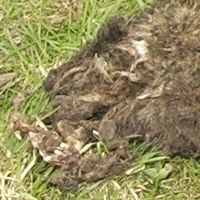 | 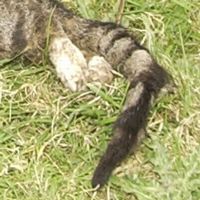 |
| Detail of the head | Detail of the tail |
I received this picture of a dead cat outside Peterhead this afternoon.
I'm told the cat measures around 3 1/2 feet, but it is missing it'shead. Looking at it, it looks far too large for a domestic cat but may be at outer limit of range. I'm pretty sure it's not a wildcat (every wildcat I've seen has a very bushy tail, as well as being a little smaller) but wondered if it may be a Kellas type... there are Kellas a few miles inland of here.
Phil Crosby, Scottish Big Cats
I have never believed there are pumas or big cats of that nature in this area. But if people saw this cat when it was alive, under the glare of headlights, they would have got quite a scare. It would look big in that situation.
I don't think this cat would have been capable of killing sheep. Possibly it could have killed a lamb. But I am sure it would have just fed off the rabbits here.
It wasn't like anything I have ever come across in these parts and we go shooting rabbits all the time.
A lot of people have said they have seen a big cat and I hope this lays their minds to rest.
Bill Duffus
I am almost certain this is just a big domestic cat. It may be a hybrid between a Scottish wild cat and a domestic cat but I do not think it is especially rare.
"Even when alive I do not think it would have been big enough to scare anyone.
Martin Gorman, of Aberdeen University's Zoology department
It seems it has been part of a private collection, perhaps from a local wildlife park. A European wildcat would be about calf-height and would be about twice the size of a normal cat. It would be easier to tell had the head been intact because they have distinctive ears.
The other thing it could be is a bobcat, which is like a puma, very hairy, and almost indistinguishable from our wildcats.
Paul Paterson, of Glasgow Zoo
The tail and its coat instantly rule it out from being a lynx although it is a similar size. Leopard cats can also be around this size.
"It seems very much like a Scottish wildcat, which are similar to domestic cats but bigger. But this is big even for them.
Ian Turner, of Longleat Safari Park
With reference to the headless body of a cat that appeared in yesterdays Press & Journal. After looking at the photography of the dead cat I thought it looked a lot like the cat in the photography taken by Steve Joyce in Tonmawr. The photography taken by Steve Joyce is of a cub and the mother is described as being a large black cat. The photograph of the Tonmawr cat appears in The Beast of Exmoor and Cat Country both written by Di Francis.
Peter Dignan
Actually I never thought of the resemblance to the cat in Di Francis' book, I see what you mean Peter. Yet another possiblity.
Have a look at http://pw2.netcom.com/~jondana/chausie.html which has images of Jungle cat/domestic hybrids. Some do bear a resemblance to the Aberdeenshire cat.
George Markie, Scottish Big Cats
Looking at the image, I find it to be interesting and unusual to say the least. The coat could be consistent with a wildcat, but the tail is much more tapered and extremely long for any domestic cat. The carcass itself, even minus the head appears much too large for either of these species.
If I had to render a guess, based on the exceptionally long tail and the animal's general size, I would have to say this is a very good candidate for a hybrid of one of the exotic cats. If only the skull was available.
I think this is one example of how often odd and unusual carcasses of animals are seen, but merely disregarded. In this case, it was photographed, so apparently the big cat publicity is reaching out.
Ben Willis, Scottish Big Cats
Interesting moggy! I agree with Ben that it could be some sort of hybrid. Hopefully the chap in the picture will still have the body and possibly DNA samples could be taken from it.
George Markie
It certainly seems at or beyond outer limits for anything but a freak domestic cat. Also the tail is too tapered for a wildcat.
Seemingly the cat had been buried for a few days then dug up to photograph.
I am unclear as to what hybrid is possible - I always felt that hybrids were difficult to achieve in the wild, as differing species did not interbreed successfully. Having said which, I accept that my knowledge ion this area is very limited. What hybrid could achieve this result?
Phil Crosby, Scottish Big Cats
Would the fact that the cat has been dead for sometime have something to do with the size, internal gasses causing bloating. Not to mention that it's being held by the tail in one pic which may cause it to stretch a bit if it's all decomposed inside (nice lunchtime topic). Mind you this is only guess work, decomposing cats isn't a pet subject of mine. Where are our biologists when we need them? >;-)
George Markie, Scottish Big Cats
Since I have had some experience with dead carcasses, both animal and human, the answer is yes, a bloated carcass might develop more than twice its normal size. In the case of this cat, it obviously isn't bloated in the image, but previously swelling could very well have caused it to stretch to an extended length.
After looking at the two images several times, and enhancing both, it appears in the first that the head is still intact. In the second, where the cat is being held by the tail, the head appears absent. Ordinarily, even in the most decomposed carcasses, the head will not simply drop off. In my experience of collecting skulls from road-kills, I find removing the head to be of some difficulty.
Assuming the size of this carcass is comparable to the living animal, the coat and tail is consistent with the Chausie breed of domestic hybrid. I'm told that they arent common in Britain but are both bred and sold there. These cats will reach upwards of 30 pounds, and can be quite long.
In any case, whatever it is, I'm glad the gentleman took the effort to photograph it and I would hope this might encourage others to do the same whenever they stumble upon some peculiar animal.
Ben Willis, Scottish Big Cats
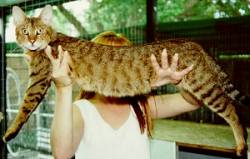
This attached image shows one of the American Chausie breeds. The coat is very similar to the Aberdeenshire cat but isn't necessarily typical of the breed. These cats are known to have a variation of markings including solid tan or melanistic. Since they are hybrid domestics, I see no reason that they wouldn't readily interbreed with feral mongrels.
Ben Willis, Scottish Big Cats
The tail is the real giveaway. Neither a domestic cat nor a wildcat has a tail that long and if it was hybrid, then they would hardly produce a tail which is as long as this.
When the (DNA) tests are run, we will be able to tell how old the animal is and that will let us know if it is a cub or a fully grown adult."
It could be a jungle cat - it has all the markings of it. But it could also be a cub of a panther-like cat, about the size of an alsatian dog, which is not foreign to this country.
I have come to the conclusion that there is an indigenous species of big cat living in the British Isles, from Cornwall to Caithness, and it has been with us since the Ice Age.
It has been here since prehistoric times but has been so secretive that is only over the last century that we have become aware of it. It is an incredible zoological scenario, which is much like that of the Loch Ness monster."
Di Francis
I'm glad to see Di Francis showing an interest in the Aberdeenshire carcass
Ben Willis, Scottish Big Cats
After looking closely at both images, I found after enhancing the one where the cat is lying on the ground, the head appears to be intact. If the cat was previously buried as stated in the article, I wonder if the head might have been severed in the digging process. The second photo, where the cat is being held by the tail, the head is obviously missing. I suspect the second photo was taken after the cat was exhumed for the purpose of scale. More likely there is a skull if someone was up for the morbid task of digging for it.
Ben Willis, Scottish Big Cats
I showed the pictures to a couple of colleagues at work, one a biologist and the other is allowed to share a house with four cats and the first thing both of them commented on was the length of the legs.
George Markie, Scottish Big Cats
I must have been half-asleep because I had not noticed initially the legs. On sober reflection, and pending any DNA tests, I am very much inclined to agree with Ben. The legs are inconsistent with the body and the body seems over-elongated - perhaps due to fairly advanced decomposition.
Phil Crosby, Scottish Big Cats
Here is an interesting observation of the Aberdeenshire photograph. The cat pictured seems to have approximately ten black rings surrounding the long tail. To my knowledge, both the African and European Wildcat have around six or seven. Perhaps Alan Paul might correct me, but I find this unusual even for a moggie. I wonder, does this mean the tail is actually longer as opposed to simply being stretched ?
Ben Willis, Scottish Big Cats
I find it incredible that so much fuss is made of a large domestic cat, with obvious white paws and skinny tail. If it has any wildcat ancestry, it's only slight. The largest wildcat on record in Scotland was 48 inches, but the largest domestic cats can be heavier and longer than wildcats. Our own domestic tom cat, (Oscar de Wilde!) is around 3.5 feet long, stretched out, and my sisters moggie makes him look small. Ailsa, our rather ordinary hybrid female wildcat was accurately measured in the vets (while asleep!) as 39".
Allan Paul, Scottish Big Cats
It reminds me of something I found on the A604 (Now the A14) I was driving towards Cambridge somewhere around the St Ives area when I saw what looked like a dead greyhound laying with its head out of sight over the verge and with it's back to me. It had a similar tail and colour to the headless cat in the article. Overall length was about 3' plus this ringed tail. I couldn't stop to examine it as the traffic was too much. I don't know a dog that has a ringed tail. This was 4 cars and 3 dogs ago so it must have been 1988 ish.
Terry.
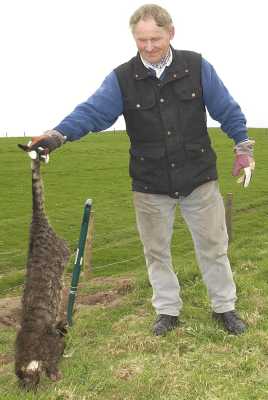 |
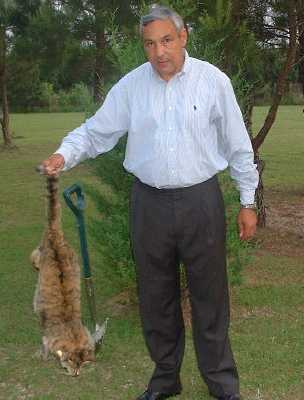 |
| Mr Duffus and the Boddam cat | Ben Willis with a feral cat |
I have been so curious of the Aberdeenshire cat that I decided to simulate an image as closely as possible which might give some idea of the cat's actual size. The cat I'm holding in this photo is a feral which was killed a year or so ago. The pelt was tanned by a taxidermist and prepared for mounting. I've wired a three litre beverage bottle to the inside for the necessary added weight.
Actually, there is no accounting for the decomposition in the Aberdeenshire cat or the height of Mr.Duffus. Assuming that he is of average height as I am at 5'11, my cat is considerably shorter than the cat pictured. The living cat which this pelt was taken was slightly larger than the average domestic at a slender and muscular 15 pounds.
One thing I notice in my photograph is the tail appears longer than it actually was in the living cat. I suspect this is partially due to it being stretched and much of the rump appears as tail.
In any case, this crude experiment doesn't necessarily prove anything significant but the results are somewhat interesting.
Ben Willis, Scottish Big Cats
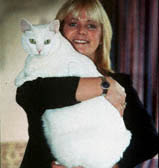 It is quite clear that this cat is not a leopard, puma or lynx. I initially thought that it was a wildcat but the tail is far too scraggy. The most likely explanation does seem to be that it is a large domestic or feral cat although I wouldn't like to completely rule out the possibility that it was some sort of hybrid.
It is quite clear that this cat is not a leopard, puma or lynx. I initially thought that it was a wildcat but the tail is far too scraggy. The most likely explanation does seem to be that it is a large domestic or feral cat although I wouldn't like to completely rule out the possibility that it was some sort of hybrid.
There are some very large domestic cats about. The biggest domestic cat ever recorded, from the Guinness Book of Records was more four times the weight of Ben's 15 lb cat and weighed no less than 96 lbs.
Snowbie, who is owned by Lorna Sutherland of Ellon, Aberdeenshire, Scotland, measured 103 cm. (40.8 in.) from his nose to the tip of his tail, on November 21, 1997, when he was four years old.
Lorna Sutherland has owned 98-lb (44-kg.) Snowbie and his sister, Booboo, since they were kittens. When Snowbie was about three months old, Lorna had him sterilized and he just kept growing and growing. He now stands 33-cm. (13-in.) tall, and his tail alone measures 31 cm. (12 in.).
This affectionate white cat certainly has a pampered lifestyle. Lorna heats his bed at night with a warm towel! His favorite breakfast is a tin of tuna fish followed by either smoked ham or flaked turkey. his favorite drinks are low-fat, long-life cream, and coffee, which he likes in the morning and at bedtime he likes a bowl of rice pudding!
Chris Smith, Scottish Big Cats
When we were discussing the white cat I had remembered reading the ninety pounds rather than estimating it from the image. I remembered when I had first seen the photo last year, I was in the process of building Exmoor's enclosure and handling eighty pound bags of cement. In considering just how heavy eighty pounds really are, it seems the lady holding this cat on her shoulder is doing so with little effort.
Not to dispute Guinness, but the enormous cat doesn't appear enormous enough for ninety pounds. That weight would be similar to an average female cougar, a rotweiler, or almost four 25 lb. bags of dog-food. An extreme few domestic cats ever reach twenty-five pounds and the few I've seen have been massive. Almost four times that weight I believe would cause a cat to be immobile. So, I only wonder if the weight printed might have been an error.
Regards, Ben Willis
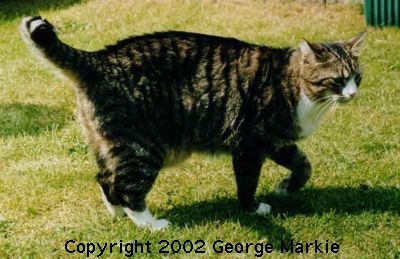
A while back I was showing pics of the Boddam cat to a colleague who mentioned that it was very similar to a friend's domestic moggie and that he would take some photos of it.
Well here they are. The beast in the pics is roughly 18 inches long and likes sleeping on people's heads! I did suggest holding it up by the tail to get a better comparison but it wasn't in a co-operative mood (well it's a cat!)
George Markie, Scottish Big Cats
The cat pictured does seem to have the same unusually long and tapered tail. The coat is also very similar.
When I did my comparison photo of the Boddam cat I tried to capture the same scale by standing in the same fashion as the man in the Boddam image. Since I didnt have any means of placing the two pictures side by side, I was unable to view both until they appeared on the site. If the scale was more consistent with the Boddam image, that cat would appear even larger by comparison. So, I'm still inclined to think there was more to that cat than merely a big feral. I hope someone is now doing a study on the cat, or at least has it in a freezer.
Ben Willis, Scottish Big Cats
Looking at the photos of the dead cat, it clearly shows it is a wild cat, (species not known) judging by the markings on the body and especially the tail, (black rings). Am almost sure this species is a Hybrid of two different wild cats, which then mated with a domestic cat. Because of the markings, the length, and the width of the cat.It is possible for this to happen.(always a first time for anything to happen).
Mrs Brown.
Difficult to gauge size with nothing to compare it wih in the photo but might it by a simple domestic x wildcat. I own a Maine Coon Cat which is an American breed and at maturity (around 4 years old) toms can weigh as much as 18lbs. Although the coat on this dead cat is too short for a Maine Coon it could be a cross.
Fran Lockhart (Inverness)
 |
 |
 |
| Return to index | Return to Scottish Big Cats | Return to Photo Album |